back to features
Macro Photography
And here is our first article, on the wonderful world of Macro Photography.
Here we will be talking about this enlightening technique, as well as providing
example shots from a talented macro photographer Akshay, who's gallery can be
found
here...
We have divided the article up into 4 sections:
1 -
What is Macro Photography
2 -
The Techy Bits
3 -
Tips and Techniques
4 -
Macro Competition
We would like to thank Akshay for the use of his great photos, and we hope that
you find this article useful.
What is Macro Photography?
We live in a world with so many fascinating things that so often go unnoticed, in
particular small items that are hard to spot with the naked human eye.
How often when we mow the lawns do we complain about those little yellow dandelions
and daisies that sprout up and let us know it is time to mow again.
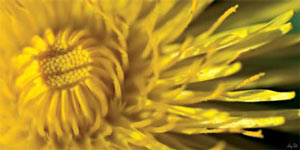

They're not so bad after all are they?
From the beauty of close up flowers, we then have the wild and wacky world of insects.
This is where Macro Photography really comes to life and you get to experience an
entirely different world.
Have a look at these photos below: (click for bigger versions)
The Techy Bits
Technically macro photography is when you produce an image
where your subject is captured in your photograph at life-size or larger with a
1:1 ratio.
Do you need a special camera for taking great Macro shots?
No, most low priced digital cameras have a macro setting of some sort, allowing
you to get up close. This is normally symbolised by a flower button or dial on your
camera.

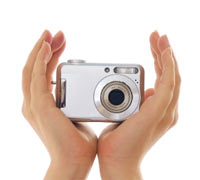
With fixed lens (lower cost) digital cameras there will be a minimum focus distance
for your macro shots. This will be found in your user manual, and in some cases
you can go as close as 1cm to your subject.
SLR Cameras
While you can achieve great results with consumer cameras, there are benefits associated
with SLR cameras.
With these cameras, the ability to take macro photographs is dependent
on the lens rather than the camera. While you can use zoom lenses for macro
photography, there are specialised macro lenses which are typically prime lenses
(fixed focus).
While proving to be very costly, these lenses are great and the quality and detail
that these lenses can capture speaks for itself.
|
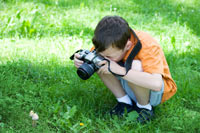
|
If you don't have the big bucks for the flashy lenses, there are also attachments
such as extension tubes and bellows that can help you achieve great results with
standard lenses.
Tips and Techniques
Keep er Steady
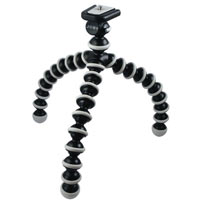
|
While you could get away with shooting handheld, a tripod is a highly recommended
accessory for macro photography. There are some pretty funky tripods available that
will allow you to get those tricky angles and stay as close to your subject as you
need to.
The tripod pictured is a Gorillapod and can be purchased for around $50 for a compact
camera and $75 for an SLR.
|
Light em Up
Experiment with your flash. You might be looking at an
aperture
of around F11 to get everything nice and sharp, and small
apertures need plenty of light.
With SLR cameras, get someone to help you and hold the flash in a position that
will best light your subject. You can use a piece of paper to reflect light back
onto your subject as well.
It is important that you don't end up with too much light, as you don't
want to over expose and lose important details in the highlights.
Focussing on Apperture
These two go hand in hand. You do not have to have everything in focus to create
a dramatic photograph. If you look at the example below, you will see some areas
that are nice and sharp, with softly focussed surroundings.
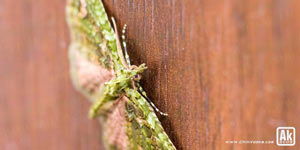
The way to control this is with your
aperture settings.
If you select a wide aperture of say 2.8 then only the closest focus point will
be in focus and the remainder of the frame will be soft.
Alternatively
if you go as narrow as F11, you should end up with everything nice and sharp.
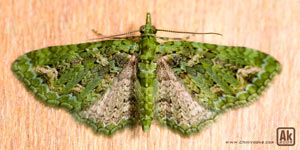
If you are photographing subjects such as insects, then it is very important that
you get the eyes tack sharp, or your macro photo will not look right. Finding the
eyes of an insect can be a mission in itself sometimes, but it is
definitely worth it!
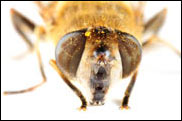
Composition
When composing your shot, a good thing to remember is the rule of thirds.
Some cameras have a grid setting on the view finder, but if this is not available
on your camera then imagine your photo is cut into a set of 3x3 squares.
Photographs have more impact when the subject is in one of the intersecting thirds
rather than the middle.
|
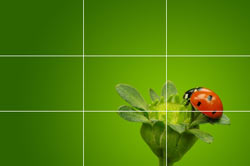
|
Have a go and WIN!!
The competition is now closed, thanks for all those great creative entries!
The winner of our Macro Feature Competition is Kelly from Wellington with his great
shot below:

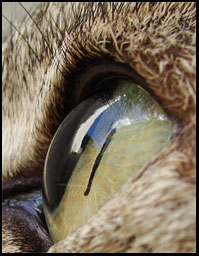
Look how nice and sharp he has got the eye to create a very powerful photograph!